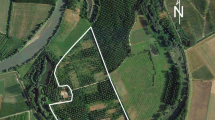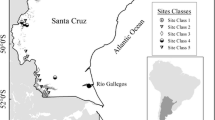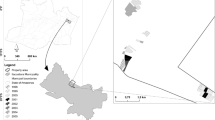Abstract
This study was carried out to identify relationships between site index (dominant height at a reference age) and ecological variables of trembling poplar forests in Türkiye. Samples were collected from 78 plots differing in elevation, aspect, inclination, slope position, and site class. Physiographic factors of the sample plots were recorded, soil samples were collected from different predefined layers from soil pits, and bedrock samples were collected for identification. From three trees at the stand top height, the tree closest to the arithmetic mean height was felled, and its height and age were determined. Physical and chemical characteristics of the soil samples were analysed. Relationships of the soil properties, physiographic factors, and climate with site index were assessed with correlation, stepwise regression, and regression tree methods. Significant relationships were found between site index at 30 years and elevation from the physiographic factors; the maximum temperature and the number of snowy days of the coldest month from the climate characteristics; fine earth, silt, and pH from the percentage values of soil properties at different depths; and fine earth, silt, and clay from the soil characteristics aggregated on pedon level. The height growth of trembling poplar was 11.8% according to stepwise regression analysis and 18% according to the regression tree method. The models obtained in the current study might help evaluate the potential of sites regarding the growth of trembling poplar.




Similar content being viewed by others
Data availability
The datasets analysed during the current study are available from the corresponding author on reasonable request.
References
Aertsen, W., Kint, V., Orshoven, J., Ozkan, K., & Muys, B. (2010). Comparison and ranking of different modelling techniques for prediction of site index in Mediterranean mountain forests. Ecological Modelling, 221(8), 1119–1130. https://doi.org/10.1016/j.ecolmodel.2010.01.007
Akkemik, Ü. (2004). Dendrochronology. Istanbul University Press. (in Turkish).
Akman, Y. (1990). Climate and bioclimate. Palme Press. (in Turkish).
Álvarez-Álvarez, P., Khouri, E. A., Cámara-Obregón, A., Castedo-Dorado, F., & Barrio-Anta, M. (2011). Effects of foliar nutrients and environmental factors on site productivity in Pinus pinaster Ait. stands in Asturias (NW Spain). Annals of Forest Science, 68, 497–509. https://doi.org/10.1007/s13595-011-0047-5
Atalay, İ. (2019). Ecology of aspen (Populus tremula L.) and their regioring in terms of seed transfer in Turkey. Poplar and Fast Growing Forest trees Research Institute Press, İzmit. (in Turkish).
Atalay, İ, Kozan, H., Altunbaş, S., & Tamyüksel, H. (2021). Growth and enlarging possibilities of aspen (Populus tremula L) in the vicinities of Erciyes Mountain and Sivas central Anatolia. Kayseri Regional Directorate of Forestry Press, Kayseri. (in Turkish).
Bravo, F., Lucà, M., Mercurio, R., Sidari, M., & Muscolo, A. (2011). Soil and forest productivity: A case study from Stone pine (Pinus pinea L.) stands in Calabria (southern Italy). iForest, 4, 25–30. https://doi.org/10.3832/ifor0559-004
Bravo, E., & Montero, G. (2001). Site index estimation in Scots pine (Pinus sylvestris L.) stands in the High Ebro Basin (northern Spain) using attributes. Forestry, 74(4), 395–406.
Bravo-Oviedo, A., & Montero, G. (2005). Site index in relation to edaphic variables in stone pine (Pinus pinea L.) stands in south west Spain. Annals of Forest Science, 62, 61–72. https://doi.org/10.1051/forest:2004086
Bravo-Oviedo, A., Roig, S., Bravo, F., Montero, G., & Del-Rio, M. (2011). Environmental variability and its relationship to site index in Mediterranean maritime pine. Forest Systems, 20(1), 50–64. https://doi.org/10.5424/fs/2011201-9106
Bremner, J. M. (1996). Nitrogen-total. In D. L. Sparks (Ed.), Methods of soil analysis—Part 3: Chemical methods (pp. 1085–1121). Soil science Society of America and American Society of agronomy.
BS EN ISO 11272. (2014). Soil quality-Determination of dry bulk density. London: The British Standards Institution Press.
Bueis, T., Bravo, F., Pando, V., & Turrion, M.-B. (2016). Relationship between environmental parameters and Pinus sylvestris L. site index in forest plantations in northern Spain acidic plateau. iForest, 9, 394–401. https://doi.org/10.3832/ifor1600-008
Caudullo, G., & de Rigo, D. (2016). Populus tremula in Europe: Distribution, habitat, usage and threats. EU, Luxembourg: European Atlas of Forest Tree Species. Publ. Off.
Chen, H. Y. H., Krestov, P. V., & Klinka, K. (2002). Trembling aspen site index in relation to environmental measures of site quality at two spatial scales. Canadian Journal of Forest Research, 32, 112–119. https://doi.org/10.1139/x01-179
Çepel, N., Dündar, M., & Günel, A. (1977). Relationship between edaphic and physiological attributes and growth of Scotch pine in important forest areas. The Scientific and Technological Research Council of Turkey Press. (in Turkish).
Çepel, N., & Gülçür, F. (1962). A study and research to determine the ecological conditions of an area to be selected as a nursery site. Forestist, A12(2), 108–119. (in Turkish).
Dewoody, J., Rowe, C. A., Hipkins, V. D., & Muck, K. E. (2009). “Pando” lives: Molecular genetic evidence of a giant aspen clone in central Utah. West. Western North American Naturalist, 68(4), 493–497. https://www.jstor.org/stable/41717712
Dhyan, S., Chhonkar, P. K., & Dwivedi, B. S. (2013). Manual on soil, plant and water analysis. Westville Publishing House, New Delhi, India.
Diéguez-Aranda, U., Álvarez González, J. G., Barrio Anta, M., & Rojo Alboreca, A. (2005). Site quality equations for Pinus sylvestris L. plantations in Galicia (northwestern Spain). Annals of Forest Science, 62, 143–152. https://doi.org/10.1051/forest:2005006
DTREG. (2022). DTREG predictive modeling software. https://www.dtreg.com/. Accessed 08 January 2022.
Ellis, B., Jansson, S., Strauss, S.H., & Tuskan, G.A. (2010). Why and how Populus became a “model tree”. In Genetics and genomics of Populus (pp. 3–14). Springer, New York, NY.
Ercanli, İ, Günlü, A., Altun, L., & Başkent, E. Z. (2008). Relationship between site index of oriental spruce [Picea orientalis (L.) Link] and ecological variables in Maçka. Turkey. Scandinavian Journal of Forest Research, 23, 319–329. https://doi.org/10.1080/02827580802249100
Ertürk, T., & Karahan, F. (2014). Investigation of aspen (Populus tremula L.) areas in Turkey. Poplar and Fast Growing Forest Trees Research Institute Press, İzmit. (in Turkish)
Eruz, E. (1984). Relationship between height growth and some edaphic and physiological attributes for Crimean pine in Balikesir Forest Enterprise. Istanbul University Press. (in Turkish).
Grant, M. C., Mitton, J. B., & Linharf, Y. B. (1992). Even larger organisms. Nature, 360, 216.
Gül, A., & Gezer, A. (2003). Use of poplar taxa for landscape planning and environment design. Turkey National Poplar Commission VII. usual assembly. Communiques. 8–9 April 2003. İzmit.
Gülsoy, S., & Çinar, T. (2019). The relationships between environmental factors and site index of Anatolian black pine (Pinus nigra Arn. subsp. pallasiana (Lamb.) Holmboe) stands in Demirci (Manisa) district, Turkey. Applied Ecology and Environmental Research, 17(1), 1235–1246. https://doi.org/10.15666/aeer/1701_12351246
Güner, Ş. T. (2021). Relationships between site index and ecological variables of oriental beech forest in the Marmara region of Turkey. Fresenius Environmental Bulletin, 30(6A), 6920–6927.
Güner, Ş. T., Özkan, K., Çömez, A., & Çelik, N. (2011). Woody indicator species of probable productive potential areas of Anatolian black pine (Pinus nigra subsp. pallasiana) in the Inner Anatolia Region. Ekoloji, 20(80), 51–58. https://doi.org/10.5053/ekoloji.2011.807
Güner, Ş. T., & Yücel, E. (2015). Relationships between growth of Pinus sylvestris ssp. Hamata factors with ecological forests in Central Anatolia. Biological Diversity and Conservation, 8(3), 6–19.
Günlü, A., Yilmaz, M., Altun, L., Ercanli, İ., & Küçük, M. (2006) Relationships between site index and some edaphic and physiographic factors of pure oriental spruce (Picea orientalis Link.) in Artvin Genya Mountain. Turkish Journal of Forestry, 7(1), 1–10. (in Turkish).
Hansen, E. A., & Dickson, R. E. (1979). Water and mineral nutrient transfer between root systems of juvenile Populus. Forest Science, 25(2), 247–252. https://doi.org/10.1093/forestscience/25.2.247
Hauke, J., & Kossowski, T. (2011). Comparison of values of Pearson’s and Spearman’s correlation coefficients on the same sets of data. Quaestiones Geographicae, 30(2), 87–93. https://doi.org/10.2478/v10117-011-0021-1
IUSS Working Group WRB. (2015). World reference base for soil resources 2014, update 2015. International soil classification system for naming soils and creating legends for soil maps. World Soil Resources Reports No. 106. FAO, Rome.
Jansson, S., & Douglas, C. J. (2007). Populus: A model system for plant biology. Annual Review of Plant Biology, 58, 435–458. https://doi.org/10.1146/annurev.arplant.58.032806.103956
Kozlowski, T. T., & Pallardy, S. G. (1997). Growth control in woody plants. Academic Press.
Kramer, P. J., & Kozlowski, T. T. (1979). Physiology of woody plants. Academica Press.
Kroetsch, D., & Wang, C. (2008). Particle size distribution, in section VI. Soil physical analysis, Section Ed. By D. A. Angers, F. J. Larney, In: M. R. Carter, E. G. Gregorich (Eds.), Soil sampling and methods of analysis 2. Edition (pp. 713–725), CRC Press, Boca Raton.
Loeppert, R. H., & Suarez, D. L. (1996). Carbonate and gypsum. In D. L. Sparks, A. L. Page, P. A. Helmke, R. H. Loeppert, P. N. Soltanpour, M. A. Tabatabai, C. T. Johnston, & M. E. Sumner (Eds.), Methods of soil analysis—Part (Vol. 3, pp. 437–474). Chemical methods. American Society of Agronomy and Soil Science Society of America, Madison.
Moisen, G. G., & Frescino, T. S. (2002). Comparing five modelling techniques for predicting forest characteristics. Ecological Modelling, 157(2–3), 209–225. https://doi.org/10.1016/S0304-3800(02)00197-7
Moreno-Fernández, D., Álvarez-Gonzálezc, J. G., Rodríguez-Soalleirod, R., Pasalodos-Tatoa, M., Cañellasa, I., Montesa, F., Díaz-Varelae, E., Sánchez-Gonzáleza, M., Crecente-Campof, F., Álvarez-Álvarezg, P., Barrio-Antag, M., & Pérez-Cruzadoc, C. (2018). National-scale assessment of forest site productivity in Spain. Forest Ecology and Management, 417, 197–207. https://doi.org/10.1016/j.foreco.2018.03.016
Nelson, D. W., & Sommers, L. E., et al. (1996). Total carbon, organic carbon, and organic matter. In D. L. Sparks (Ed.), Methods of soil analysis—Part (Vol. 3, pp. 961–1010). Chemical Methods. Soil Science Society of America and American Society of Agronomy, Madison, WI.
Özel, C., Güner, Ş. T., Türkkan, M., Akgül, S., & Şentürk, Ö. (2021). Modelling the site index of Pinus pinaster plantations in Turkey using ecological variables. Journal of Forest Research, 32, 589–598. https://doi.org/10.1007/s11676-020-01113-x
Özkan, K. (2012). Modelling ecological data using classification and regression tree technique (CART). Turkish Journal of Forestry, 13, 1–4. (in Turkish).
Özkan, K., Gülsoy, S., & Mert, A. (2008). Interrelations between height growth and site characteristics of Pinus nigra Arn. ssp. pallasiana (Lamb.) Holmboe. The Malaysian Forester, 71, 9–16.
Peltzer, D. A. (2002). Does clonal integration improve competitive ability? A test using aspen (Populus tremuloides) invasion into a prairie. American Journal of Botany, 89, 494–499. https://doi.org/10.3732/ajb.89.3.494
Pitelka, L. F., & Ashmun, J. (1985). Physiology and integration of ramets in clonal plants. In J. B. C. Jackson, L. W. Buss, & R. E. Cook (Eds.), In Population biology and evolution of clonal organisms (pp. 399–437). Yale University Press.
Rhoades, J. D. (1996). Salinity: Electrical conductivity and total dissolved solids. In: D. L. Sparks, page a.L., P. A. Helmke, R. H. Loeppert, P. N. Soltanpour, M. A. Tabatabai, C. T. Johnston, M. E. Sumner (eds.) Methods of soil analysis – Part 3. Chemical methods. American Society of Agronomy and Soil Science Society of America, Madison, Wisconsin. p. 417–435.
Rogers, P. C., Pinno, B. D., Šebesta, J., Albrectsen, B. R., Li, G., Ivanova, N., Kusbach, A., Kuuluvainen, T., Landhäusser, S. M., Liu, H., Myking, T., Pulkkinen, P., Wen, Z., & Kulakowski, D. (2021). A global view of aspen: Conservation science for widespread keystone systems. Global Ecology and Conservation, 21, e00828. https://doi.org/10.1016/j.gecco.2019.e00828
Saribaş, M. (1989). Research on the morphological (external morphological, internal morphological and palynological) characteristics of poplars growing naturally in the Euro-Siberian (Euxine) Region of Turkey. Poplar and Fast Growing Forest Trees Research Institute Press. (in Turkish).
Serdar, B., & Gerçek, Z. (2007). Variations of wood anatomical features of polar (Populus L.) depending on non-anatomical factors. Düzce University Journal of Forestry, 3(1), 76–89. (in Turkish).
Seynave, I., Gégout, J.-C., Hervé, J.-C., Dhôte, J.-F., Drapier, J., Bruno, É., & Dumé, G. (2005). Picea abies site index prediction by environmental factors and understorey vegetation: A two-scale approach based on survey databases. Canadian Journal of Forest Research, 35, 1669–1678. https://doi.org/10.1139/X05-088
SPSS v.22.0®. (2015). SPSS 22.0 Guide to Data Analysis. Prentice Hall, Upper Saddle River, New Jersey, USA.
Taylor, G. (2002). Populus: Arabidopsis for forestry. Do we need a model tree. Annals of Botany, 90, 681–689. https://doi.org/10.1093/aob/mcf255
Thomas, G. W. (1996). Soil pH and Soil Acidity. In: Methods of Soil Analysis: Part 3 Chemical Methods, 5.3. Sparks, D., Page, A., Helmke, P., Loeppert, R., Soltanpour, P. N., Tabatabai, M. A., Johnston C. T., Sumner M. E. (Eds.). American Society of Agronomy, Madison, Wisconsin, USA, pp. 475–490.
Tunçer, A. (2008). The morphogenetic investigation of natural European aspen exemplified from stand in populations in Giresun Şebinkarahisar district. Master of Science Thesis, Karadeniz Technical University. Trabzon. (in Turkish).
von Wühlisch, G. (2009). Technical guidelines for genetic conservation and use of Eurasian aspen (Populus tremula). Rome, Italy: EUFORGEN Press.
Worrell, R. (1995). European aspen (Populus tremula L.): A review with particular reference to Scotland 1. Distribution, ecology and genetic variation. Forestry, 68(2), 93–105. https://doi.org/10.1093/forestry/68.2.93
Yaman, B., & Saribaş, M. (2004). Vessel size variability of poplar (Populus L.) species in relation to altitude in Euxine region of Turkey. Turkish Journal of Forestry, A(1), 111–123. (in Turkish).
Yavuz, H., Misir, N., & Misir, M. (2004). Growth models for black pine plantations. The Scientific and Technological Research Council of Turkey (TUBİTAK), Project Number: 2747, Trabzon. (in Turkish).
Yener, İ., & Altun, L. (2018). Predicting site index for oriental spruce (Picea orientalis L. (Link)) using ecological factors in the eastern black sea, Turkey. Fresenius Environmental Bulletin, 27(5), 3107–3116.
Acknowledgements
This study was conducted as part of the project “Relations Between Stand Growth and Site Properties of Eurasian Aspen (Populus tremula L.) in Turkey [Project No: IZT-410(6300)/2018-2021]” funded by the Turkish General Directorate of Forestry.
Funding
This work was supported by the Turkish General Directorate of Forestry (Project No.: IZT-410(6300)/2018–2021).
Turkish General Directorate of Forestry,IZT-410(6300)/2018-2021
Author information
Authors and Affiliations
Contributions
Ercan Velioğlu: conceptualization, investigation, methodology, data curation, review, and final editing. Şükrü Teoman Güner: conceptualization, investigation, methodology, data curation, writing-original draft, review, and final editing. Hidayet Karakurt: investigation, methodology, and data curation. Yusuf Taştan, Zuhal Yavuz, and Dilek Tuğrul: read and approved the final manuscript.
Corresponding author
Ethics declarations
Ethics approval
All authors have read, understood, and have complied as applicable with the statement on “ethical responsibilities of authors.”
Consent to participate
Not applicable.
Consent for publication
Not applicable.
Conflict of interest
The authors declare no competing interests.
Additional information
Publisher's Note
Springer Nature remains neutral with regard to jurisdictional claims in published maps and institutional affiliations.
Rights and permissions
Springer Nature or its licensor (e.g. a society or other partner) holds exclusive rights to this article under a publishing agreement with the author(s) or other rightsholder(s); author self-archiving of the accepted manuscript version of this article is solely governed by the terms of such publishing agreement and applicable law.
About this article
Cite this article
Velioğlu, E., Güner, Ş.T., Karakurt, H. et al. Relationships between site index and ecological variables of trembling poplar forests (Populus tremula L.) in Türkiye. Environ Monit Assess 195, 308 (2023). https://doi.org/10.1007/s10661-023-10933-3
Received:
Accepted:
Published:
DOI: https://doi.org/10.1007/s10661-023-10933-3




